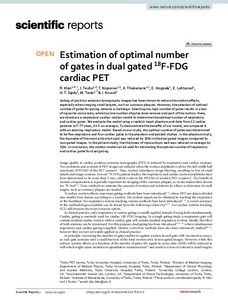Estimation of optimal number of gates in dual gated F-18-FDG cardiac PET
Klen R; Teuho J; Noponen T; Thielemans K; Hoppela E; Lehtonen E; Sipilä HT; Teräs M; Knuuti J
Estimation of optimal number of gates in dual gated F-18-FDG cardiac PET
Klen R
Teuho J
Noponen T
Thielemans K
Hoppela E
Lehtonen E
Sipilä HT
Teräs M
Knuuti J
NATURE RESEARCH
Julkaisun pysyvä osoite on:
https://urn.fi/URN:NBN:fi-fe2021042824768
https://urn.fi/URN:NBN:fi-fe2021042824768
Tiivistelmä
Gating of positron emission tomography images has been shown to reduce the motion effects, especially when imaging small targets, such as coronary plaques. However, the selection of optimal number of gates for gating remains a challenge. Selecting too high number of gates results in a loss of signal-to-noise ratio, while too low number of gates does remove only part of the motion. Here, we introduce a respiratory-cardiac motion model to determine the optimal number of respiratory and cardiac gates. We evaluate the model using a realistic heart phantom and data from 12 cardiac patients (47-77 years, 64.5 on average). To demonstrate the benefits of our model, we compared it with an existing respiratory model. Based on our study, the optimal number of gates was determined to be five respiratory and four cardiac gates in the phantom and patient studies. In the phantom study, the diameter of the most active hot spot was reduced by 24% in the dual gated images compared to non-gated images. In the patient study, the thickness of myocardium wall was reduced on average by 21%. In conclusion, the motion model can be used for estimating the optimal number of respiratory and cardiac gates for dual gating.
Kokoelmat
- Rinnakkaistallenteet [27094]
